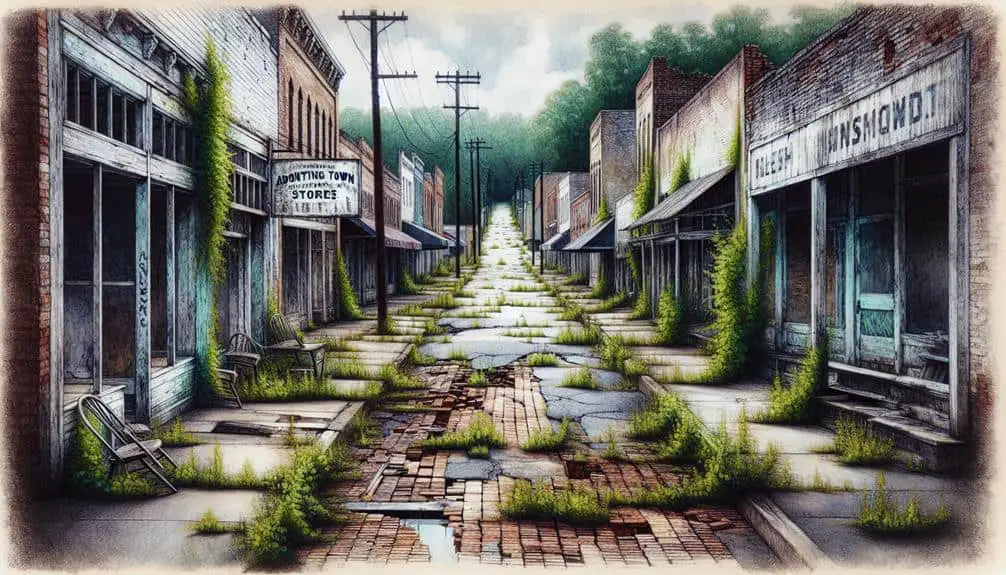In the South, deserted suburban areas stem from historical economic shifts and shifting demographics, leading to urban sprawl effects. Economic struggles like job losses and lacking diversity hinder revitalization. Changing demographics with urbanization and aging populations impact community dynamics. Abandoned suburbs face environmental damage like degraded infrastructure and ecological imbalances. Solutions involve engaging communities, mixed-use zones, and green infrastructure for sustainability and growth. Understanding the complex reasons behind desertion can offer insights into how to address these issues effectively.
Key Points
- Economic shifts and changing demographics led to suburban exodus.
- Deteriorating infrastructure and lack of investment contributed to desertion.
- Lack of diverse industries and job opportunities caused economic instability.
- Urban sprawl and population shifts disconnected communities in deserted suburbs.
- Environmental degradation and decay worsened by abandoned suburban areas.
Historical Factors Contributing to Desertion
During the mid-20th century, economic shifts and changing demographics in the South led to a significant exodus from suburban areas, resulting in their eventual desertion. Colonial influence played an important role in shaping the development of these suburbs, leading to the establishment of neighborhoods that were later affected by urban sprawl.
As cities expanded, suburbs faced challenges such as deteriorating infrastructure, lack of investment, and shifting employment opportunities.
To address these historical factors contributing to desertion, a thorough revitalization strategy is imperative. Initiatives focusing on infrastructure rehabilitation, economic diversification, and community engagement can help breathe new life into these deserted suburban areas. By leveraging historical preservation efforts and promoting sustainable development practices, these regions can reclaim their identity and attract residents back to their once vibrant neighborhoods.
Understanding the root causes of suburban desertion is essential for devising effective solutions that empower communities to thrive once again. Through strategic planning and targeted interventions, these areas can overcome their historical challenges and forge a path towards a prosperous future.
Economic Challenges Faced by Residents
The historical factors contributing to the desertion of suburban areas in the South have left residents grappling with significant economic challenges, impacting their livelihoods and community well-being. Job opportunities in these deserted areas have dwindled over the years, leading to high unemployment rates and financial instability for many residents. The lack of diverse industries and businesses has hindered economic growth and forced residents to seek employment opportunities elsewhere, disrupting the social fabric of these communities.
Moreover, the absence of adequate social services in deserted suburban areas further exacerbates the economic challenges faced by residents. Limited access to essential services such as healthcare, education, and affordable housing creates barriers to upward mobility and overall well-being. Addressing these economic challenges requires a multi-faceted approach that focuses on revitalizing local economies, attracting new businesses, and improving access to job training programs and social services.
Impact of Changing Demographics
With shifting population trends and evolving community dynamics, understanding the impact of changing demographics on deserted suburban areas in the South is essential for devising effective revitalization strategies. Population shifts and cultural changes have played a significant role in the abandonment of these once-thriving neighborhoods. As urban sprawl continues to draw residents towards city centers, suburbs are left grappling with community disconnection and a lack of vibrancy. The changing demographics, characterized by a mix of aging populations, migration patterns, and evolving household structures, have left many suburban areas struggling to adapt.
To address these challenges, a holistic approach is needed. Initiatives that foster community engagement, promote diversity, and cater to the varied needs of residents can breathe new life into these deserted suburban areas. By leveraging the strengths of changing demographics, such as embracing cultural diversity and tailoring services to different age groups, these communities can transform into vibrant, inclusive spaces once again. It's vital to recognize the potential within shifting demographics and harness it to revitalize deserted suburban areas in the South.
Environmental Concerns in Abandoned Suburbs
Amidst the desolation of abandoned suburban areas in the South, environmental concerns loom large, demanding urgent attention and strategic interventions. Urban sprawl has contributed greatly to this issue, with vast expanses of land being developed rapidly and then left deserted, leading to ecological imbalances. The ramifications of urban sprawl extend beyond aesthetics; they encompass environmental degradation, loss of biodiversity, and disruption of natural habitats.
Infrastructure decay further exacerbates these environmental concerns. Abandoned suburbs often have crumbling roads, deteriorating buildings, and neglected public spaces. These decaying structures not only pose safety hazards but also contribute to pollution through the release of harmful substances into the environment.
Addressing the environmental challenges in abandoned suburbs requires a holistic approach that considers remediation, conservation, and sustainable redevelopment. Strategies such as repurposing vacant lots for green spaces, implementing eco-friendly infrastructure projects, and promoting community engagement in environmental restoration efforts can help mitigate the negative impact of abandoned suburban areas on the environment. By taking proactive steps to address these issues, we can work towards creating healthier and more sustainable communities for the future.
Potential Solutions for Revitalization
In light of the pressing environmental concerns in abandoned suburban areas in the South, exploring potential solutions for revitalization is imperative for restoring ecological balance and fostering sustainable communities. To achieve this goal, active community engagement and innovative urban planning strategies are essential.
Here are some actionable steps to kickstart the revitalization process:
- Community Engagement: Encourage residents, local businesses, and stakeholders to participate in decision-making processes. By involving the community in revitalization efforts, you can guarantee that projects align with the needs and aspirations of the people living in these areas.
- Urban Planning: Implement mixed-use zoning regulations to promote walkability and reduce car dependency. By creating vibrant, pedestrian-friendly neighborhoods with a mix of residential, commercial, and green spaces, you can enhance the overall quality of life in abandoned suburban areas.
- Green Infrastructure Development: Integrate green infrastructure such as parks, community gardens, and green roofs to improve air quality, manage stormwater runoff, and create recreational spaces for residents.
- Public-Private Partnerships: Foster collaborations between local governments, private developers, and non-profit organizations to leverage resources and expertise effectively. By working together, you can implement sustainable revitalization projects that benefit the entire community.
Frequently Asked Questions
How Do Abandoned Suburban Areas in the South Compare to Those in Other Regions of the Country?
When comparing abandoned suburban areas in the South to those in other regions, you'll notice variations in urban planning, demographic shifts, economic development, and community revitalization efforts. Understanding these differences is key to fostering positive change.
Are There Any Cultural Factors That Have Influenced the Desertion of Suburban Areas in the South?
Cultural influences play a significant role in the desertion of suburban areas in the South. Economic factors also contribute to this trend. Understanding these influences can help address and potentially revitalize these abandoned communities.
What Role, if Any, Do Local Government Policies Play in the Abandonment of Suburban Neighborhoods?
Local government policies, especially in zoning and economic development, heavily influence suburban neighborhood abandonment. When rules restrict growth or neglect infrastructure, communities suffer. It's imperative for authorities to adapt policies for sustainable progress.
How Have Technological Advancements and Changes in Transportation Affected the Desertion of Suburban Areas in the South?
Transportation innovations and the impact of automation have accelerated urban sprawl, contributing to economic decline in many southern suburban areas. These advancements have made commuting easier, leading to deserted neighborhoods as people seek convenience.
What Are Some Potential Long-Term Consequences of Leaving Suburban Areas Deserted in Terms of Infrastructure and Public Services?
Like a garden left untended, deserted suburban areas in the South face economic decay and social disarray. Long-term consequences include crumbling infrastructure, decreased property values, and strained public services, demanding revitalization efforts.



